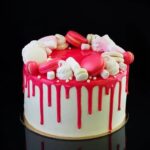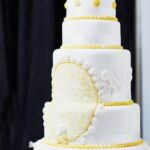What flowers can I use to decorate a cake? Flowers are a beautiful and versatile way to decorate cakes, adding an elegant and charming touch to any dessert.
Whether you’re looking to create a rustic, romantic, or modern look, incorporating flowers into your cake decoration can elevate the overall presentation. In this article, we will explore the various options for using flowers to decorate cakes, including edible and non-edible flower choices, tips for proper preparation and arrangement, as well as important considerations for safety.
Using flowers to decorate cakes can be a stunning way to enhance the visual appeal of your dessert. From delicate blooms to vibrant blossoms, there are endless possibilities for creating unique and eye-catching designs. However, it’s important to understand the differences between edible and non-edible flowers and how to safely use them on cakes. We will delve into this topic in detail, providing valuable insights on how to incorporate flowers into your cake decorating process.
In addition to discussing safe flower options for cake decoration, we will also highlight popular edible flowers that can not only add beauty but also flavor to your confectionery creations. Furthermore, we will explore non-edible flower options that can be used purely for decorative purposes on cakes. Whether you prefer fresh or dried flowers, there are various options available for achieving your desired aesthetic.
Edible vs Non-Edible Flowers
When it comes to decorating a cake with flowers, one of the most important considerations is whether the flowers are edible or non-edible. Understanding the difference between these two types of flowers is crucial for ensuring the safety of your cake and those who will be enjoying it.
Edible flowers are not only beautiful but also safe for consumption, making them an ideal choice for decorating cakes. Some popular edible flowers that can be used to elevate both the look and taste of a cake include:
- Roses
- Violets
- Lavender
- Calendula
- Nasturtiums
On the other hand, non-edible flowers should be used solely for decorative purposes and need to be handled with care to avoid any potential health risks. Some non-edible flowers that can be safely used on cakes for their visual appeal include:
- Ranunculus
- Sunflowers
- Dahlias
- Hydrangeas
- Tulips
It’s important to remember that when using non-edible flowers on a cake, they should be placed on a barrier (such as parchment paper or plastic wrap) to ensure that they do not come into direct contact with the cake itself. This will prevent any potential contamination from occurring.
Ultimately, whether you choose to use edible or non-edible flowers for decorating a cake, it’s essential to handle them with care and consideration for both aesthetic and safety purposes.
Safe Flowers for Cake Decoration
When it comes to decorating cakes with flowers, it is important to use the right kind of flowers to ensure that they are safe for consumption. Many people often wonder, “What flowers can I use to decorate a cake?” and it’s essential to be aware of the flowers that are safe and non-toxic for this purpose. In this section, we will provide a comprehensive list of flowers that are considered safe for cake decoration.
One of the most popular choices for edible flowers on cakes is the rose. Not only do roses add a touch of elegance to a cake, but they also offer a delicate floral flavor that complements various types of desserts. Other popular edible flowers include violets, pansies, lavender, and chamomile. These flowers not only enhance the visual appeal of the cake but also contribute unique and pleasant flavors.
For those looking to add non-edible flowers to their cake decorations, options such as carnations, roses, and marigolds can be used. However, it’s important to note that while these flowers are non-toxic, they should be used sparingly and removed before serving the cake. It’s best to use organic or pesticide-free flowers when incorporating them into cake decorations.
In addition to the listed options, other safe flowers for cake decoration include daisies, jasmine, hibiscus, and lilac. When using any type of flower on a cake, it is crucial to ensure that they have not been treated with chemicals or pesticides. By choosing safe and non-toxic flowers for cake decoration, you can create stunning and flavorful desserts that are both visually appealing and enjoyable to eat.
Edible Flower Options
When it comes to decorating a cake with edible flowers, it’s important to choose blooms that not only look beautiful but also complement the flavor of the cake. One popular option is using roses, which have a delicate flavor and a stunning appearance. You can use whole rosebuds or individual petals to create an elegant and romantic cake design.
Another favorite choice for edible flower decoration is lavender. Not only does it add a lovely pop of color to the cake, but it also infuses the dessert with a subtle floral essence. Lavender pairs well with lemon, vanilla, and honey-flavored cakes, making it a versatile option for various cake recipes.
Additionally, violets are often used to adorn cakes due to their vibrant purple hue and sweet floral taste. These dainty flowers can be crystallized and used as eye-catching cake decorations, adding both visual appeal and a light, fragrant flavor to the dessert.
It’s essential to remember that not all flowers are safe for consumption, so it’s crucial to do thorough research or consult with a professional before using any blooms on your cakes. By selecting the right edible flowers for your cake decoration, you can elevate both the look and taste of your baked creations.
| Edible Flower | Flavor Profile |
|---|---|
| Roses | Delicate and romantic |
| Lavender | Subtle floral essence |
| Violets | Sweet and fragrant |
Non-Edible Flower Options
When it comes to decorating cakes with flowers, there are a wide variety of non-edible options that can be used to create stunning and unique designs. While non-edible flowers should not be consumed, they can add a beautiful touch to cakes for special occasions. From fresh blooms to sugar flowers, here are some popular non-edible flower options that can take your cake decoration to the next level.
Fresh Flowers
Fresh flowers can be a visually striking addition to cake decoration. However, it is crucial to ensure that the flowers used are safe and free from chemicals. Edible organic flowers such as roses, lavender, and pansies can be used to decorate cakes with their natural beauty. It is essential to thoroughly clean and prepare fresh flowers before using them on a cake to remove any traces of pesticides or dirt.
Sugar Flowers
Sugar flowers are a popular choice for cake decoration as they offer the flexibility of creating customized designs without the concern of toxicity. These delicate and intricately crafted decorations are made from sugar paste or gum paste and can be shaped and colored to mimic real flowers. Sugar flowers provide an elegant and timeless touch to any cake design, making them perfect for weddings or other special occasions.
Wafer Paper Flowers
Wafer paper flowers are another non-edible option that can add a delicate and ethereal element to cake decoration. These thin edible paper sheets can be cut, folded, and shaped into various floral designs such as roses, peonies, or cherry blossoms. Wafer paper flowers are lightweight and easy to work with, making them a versatile choice for creating intricate floral decorations on cakes.
By incorporating non-edible flower options such as fresh blooms, sugar flowers, or wafer paper decorations into your cake designs, you can elevate the visual appeal of your creations while ensuring safety for consumption. It is important to carefully select and prepare non-edible flowers for use on cakes in order to achieve stunning and safe decorative results that will impress everyone who lays eyes on your masterpiece.
Tips for Decorating With Flowers
When it comes to decorating a cake with flowers, it’s important to know the proper techniques and considerations to ensure a beautiful and safe result. Whether you’re using edible or non-edible flowers, there are some expert tips that can help you create a stunning floral arrangement on your cakes.
Choosing the Right Flowers
The first step in decorating a cake with flowers is choosing the right blooms for the job. If you want to use edible flowers, make sure to select varieties that are safe for consumption and free from pesticides. Popular options include roses, violets, pansies, and lavender. For non-edible flowers, consider using varieties such as daisies, peonies, orchids, or carnations for their vibrant colors and long-lasting freshness.
Preparing the Flowers
Before placing any flowers on a cake, it’s crucial to prepare them properly. For edible flowers, gently wash them under cool water and allow them to dry completely on paper towels. If using non-edible flowers, remove any stems or leaves that may have come into contact with pesticides or other harmful substances. It’s also important to ensure that the chosen flowers are free of dirt and insects before incorporating them into cake decoration.
Arranging the Flowers
Once the flowers are prepared, it’s time to arrange them on the cake. When placing flowers directly onto frosting or icing, be sure to carefully position them so that they do not touch any part of the cake that will be consumed.
Consider creating a visually pleasing pattern by clustering smaller blooms together or draping larger blossoms across the top of the cake. Additionally, using flower picks or food-safe floral tape can help secure larger blooms in place without damaging the delicate surface of the cake.
By following these expert tips for decorating with flowers on cakes, you can ensure a visually stunning and safe result that will elevate your baked creations to new heights.
Flower Decoration Techniques
When it comes to incorporating flowers into cake decoration, there are various techniques that can be used to achieve stunning results. One popular method is to simply place fresh edible flowers on top of the cake or around the edges for a natural and elegant look. Before placing the flowers on the cake, it is important to ensure that they are food safe and free from any chemicals or pesticides.
Another technique for incorporating flowers into cake decoration is to press them into the frosting or icing. This can create a beautiful and seamless look, as the flowers become part of the design of the cake itself. To do this, gently press edible flowers into the frosting or icing, making sure to arrange them in a visually appealing way.
For a more intricate and artistic approach, some bakers like to use flower petals to create designs or patterns on the surface of the cake. This can be achieved by carefully arranging individual petals in various shapes and formations, such as concentric circles or geometric patterns. Non-edible flowers can also be used for this purpose, as long as they are removed from the cake before serving.
Whether you choose to simply place whole flowers on top of your cake, press them into the frosting, or use their petals to create designs, incorporating flowers into cake decoration adds a touch of natural beauty and elegance. It’s essential to handle them with care and ensure they are food safe before using them for decorative purposes. By following these techniques, you can elevate your cakes with stunning floral arrangements that will impress your guests.
Cautions and Considerations
In conclusion, decorating a cake with flowers can add a beautiful and elegant touch to any occasion. Whether you choose edible or non-edible flowers, it is important to consider the safety and proper handling of the flowers. When using flowers for cake decoration, it is crucial to ensure that they are safe for consumption and have not been treated with any harmful chemicals.
It is essential to turn to experts or reliable sources when identifying safe flowers for cake decoration. Edible options such as roses, violets, and lavender can not only enhance the visual appeal of your cake but also add unique flavors. Non-edible options like orchids, peonies, and carnations can be used solely for decorative purposes and should be carefully positioned on the cake to avoid direct contact with the frosting or icing.
When preparing to decorate a cake with flowers, always remember to thoroughly wash and sanitize them before use. It is best to place a barrier between the flowers and the cake’s surface to prevent any potential contamination.
By following these cautions and considerations, you can ensure that your floral cake decorations are not only visually stunning but also safe for consumption. So next time you find yourself asking “what flowers can I use to decorate a cake,” make sure you keep these tips in mind for a successful floral cake decoration experience.
Frequently Asked Questions
What Flowers Are Safe to Put on Cakes?
It is safe to put edible flowers like roses, violets, pansies, and chamomile on cakes. These flowers are non-toxic and can add a beautiful, natural touch to cake decorations.
Can I Use Fresh Flowers to Decorate a Cake?
Yes, you can use fresh flowers to decorate a cake as long as they are organic or edible flowers that have not been treated with chemicals or pesticides. It’s important to thoroughly wash the flowers before placing them on the cake.
What Real Flowers Are Best for Cakes?
Some of the best real flowers for cakes include roses, lavender, calendula, and citrus blossoms. These flowers not only look stunning but also offer a delicate fragrance that can enhance the overall appeal of the cake. Always ensure that the flowers are safe for consumption before using them on cakes.

Welcome to my blog about home and family. This blog is a place where I will share my thoughts, ideas, and experiences related to these important topics. I am a stay-at-home mom with two young children. I hope you enjoy reading it! and may find some helpful tips and ideas that will make your home and family life even better!





